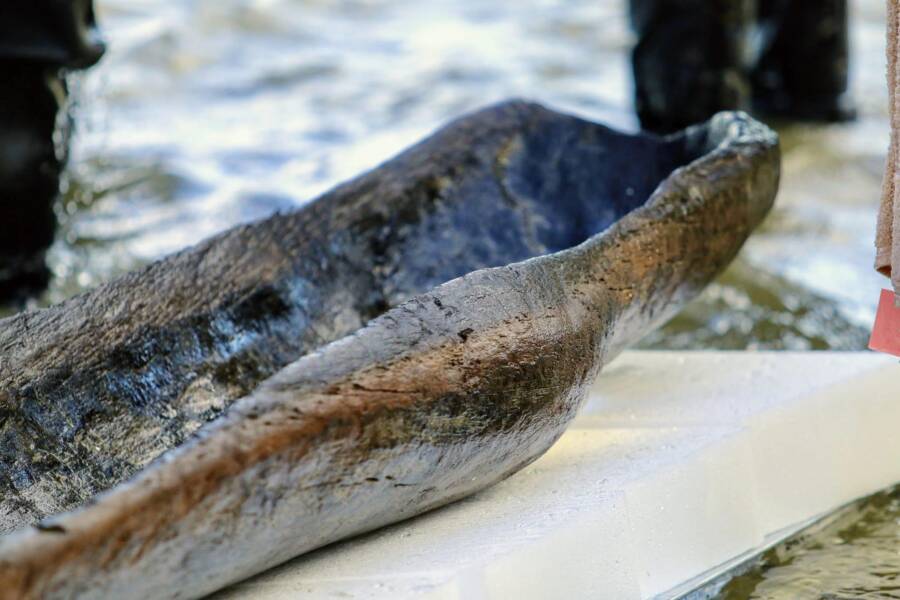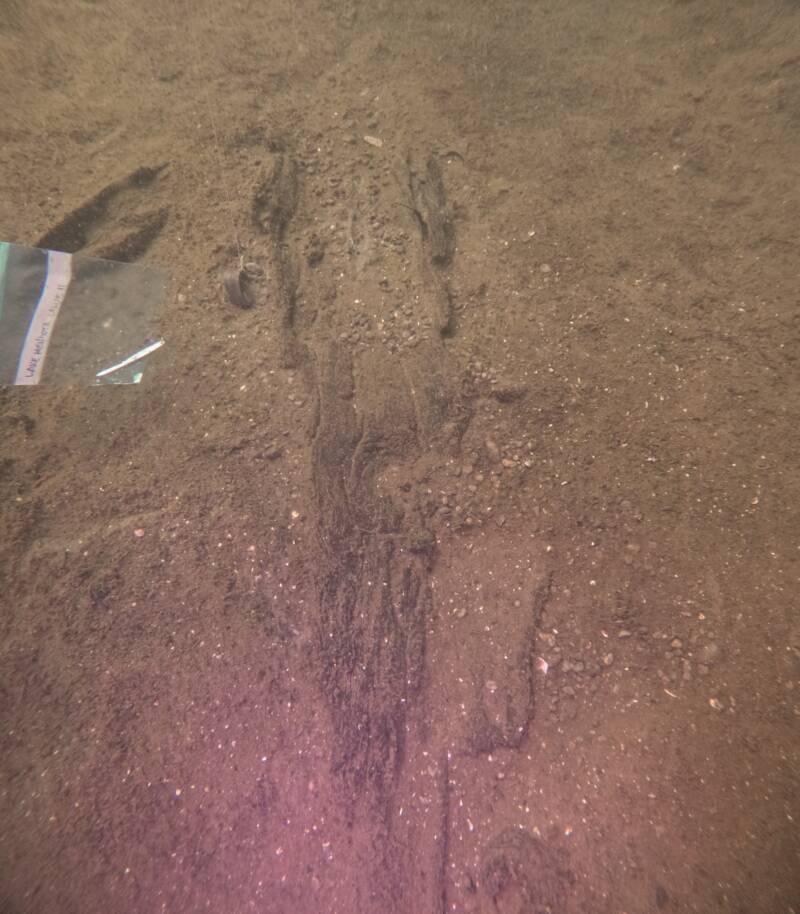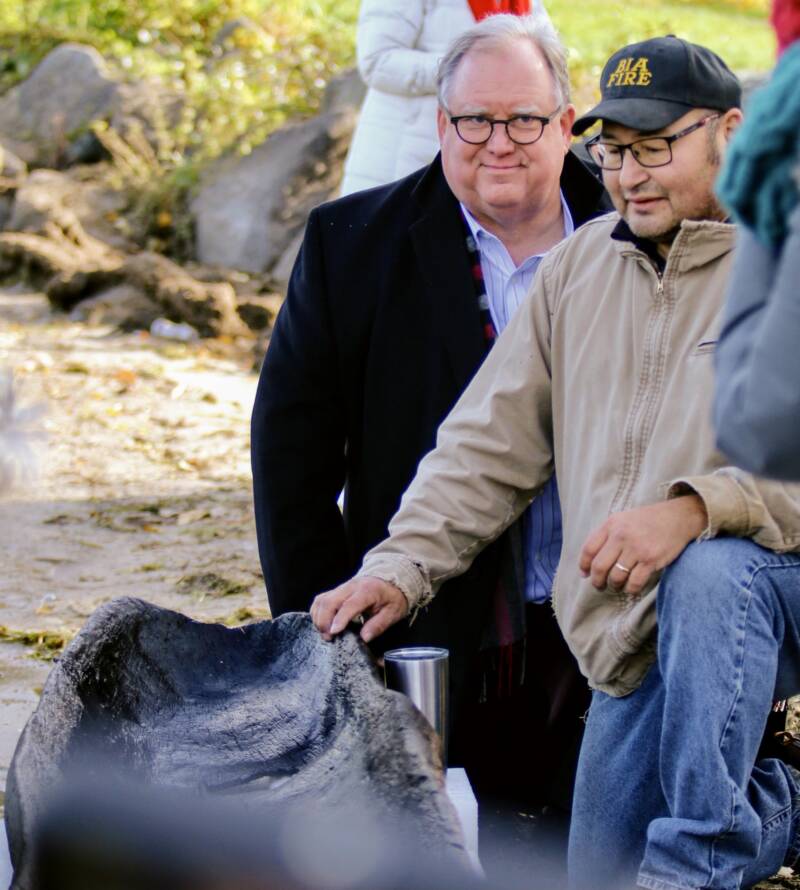The canoes were found in a section of the lake that may have served as an ancient "parking lot" for millennia.

Wisconsin Historical Society/FacebookThe first ancient canoe was found in Lake Mendota back in 2021.
Over the past four years, archaeologists have uncovered 16 ancient canoes left along the shore of Wisconsin’s Lake Mendota by Indigenous people who once lived in the area. While experts have floated several theories about why there are so many boats at the site, they now think the area where the canoes were found functioned as a sort of “parking lot.”
The site was located near a network of Indigenous trails, supporting the theory that ancient residents of Wisconsin disembarked at the location and proceeded to travel by foot to their destinations. What’s more, researchers believe the canoes were shared among the community and left floating in the lake for anyone to use as needed.
Analysis of the artifacts is still ongoing, and archaeologists hope to find even more specimens to learn more about the area’s ancient past.
The 16 Canoes Found In Lake Mendota
The research into these canoes has been ongoing for several years, ever since the first vessel was found in 2021. Now, a total of 16 wooden canoes have been identified, ranging in age from 700 to 5,200 years old.

Wisconsin Historical Society/FacebookThe oldest canoe found in Lake Mendota, which is about 5,200 years old.
Experts’ latest theory is that the site was used as a type of docking station where anybody who needed to travel across Lake Mendota could board a canoe and later return it to the same spot — similar to a modern bike share arrangement.
“It’s a parking spot that’s been used for millennia, over and over,” Wisconsin’s maritime archaeologist, Tamara Thomsen, told the Associated Press.
These canoes were found with the help of Ho-Chunk Nation preservation officers and the Bad River Band of Lake Superior Chippewa. While the locations of 16 vessels have been mapped, just two have been pulled from the water so far. Still, scientists have been able to analyze the canoes that are still submerged — to surprising results.

Wisconsin Historical Society/FacebookA map of the 16 canoes discovered by archaeologists.
According to the Wisconsin Historical Society, the most recent boat is 700 years old, while the oldest dates back an astonishing 5,200 years. That makes it the third-oldest canoe ever discovered in eastern North America. It was built before the Great Pyramid of Giza.
And researchers think that the lake could be hiding an even older canoe beneath its waters.
What These Canoes Tell Us About Indigenous Life
About 7,500 years ago, Wisconsin began experiencing a drought that lasted until around 1000 B.C.E. While the section of the lake where the canoes were found is 24 feet deep today, it was probably less than four feet deep when the boats were “parked” there, making it the ideal location for people to disembark for foot travel.
Since this drought started 7,500 years ago, experts believe that they may eventually find a canoe that dates back that far.

Wisconsin Historical Society/FacebookBill Quackenbush (right) alongside Christian Overland, the director of the Wisconsin Historical Society, looking over the canoe retrieved in 2021.
For now, however, researchers are analyzing the boats they have found to learn more about the people who crafted them. They think members of the Ho-Chunk Nation may have used the canoes to travel across Lake Mendota and then walked to Lake Wingra, the location of a sacred spring they believed was a portal to the spirit world.
“The canoes give us insight into a sophisticated travel network and interconnected communities who used their incredible skills and knowledge to live and thrive on lands where we still live and thrive today,” said Larry Plucinski, the Tribal Historic Preservation Officer of the Bad River Band of Lake Superior Chippewa. “They reflect a deep relationship with the environment and the ingenuity of our ancestors.”
And Bill Quackenbush, Ho-Chunk Nation’s tribal preservation officer, stated that the research project allows for a deeper understanding of Indigenous life and serves as a reminder of how long Indigenous people have lived in Wisconsin.
“It is important that we document and share these stories so our youth feel that connection to our past,” Quackenbush explained. “Protecting and preserving this knowledge ensures that the next generation understands where we come from and why these stories matter.”
After reading about the canoe “parking lot” found in a Wisconsin lake, learn about these famous sunken ships from history. Then, go inside the legend of the “Wisconsin Werewolf.”





